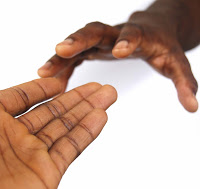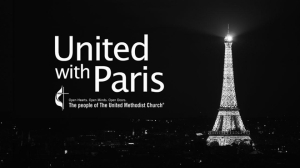
Advent is here… and the journey has begun.
 As we prepare our own hearts and homes for the mystery of Christmas, we are called to remember the Holy Family- Mary and Joseph alongside a donkey- who made the long journey to Bethlehem together. As we picture the Holy Family- Joseph leading the donkey, Mary sometimes riding and sometimes walking- we recognize the difficulty that comes when we make a long journey. And we, like the Holy Family, move forward in HOPE. Hope for all that is promised in the gift of the Christ child.
As we prepare our own hearts and homes for the mystery of Christmas, we are called to remember the Holy Family- Mary and Joseph alongside a donkey- who made the long journey to Bethlehem together. As we picture the Holy Family- Joseph leading the donkey, Mary sometimes riding and sometimes walking- we recognize the difficulty that comes when we make a long journey. And we, like the Holy Family, move forward in HOPE. Hope for all that is promised in the gift of the Christ child.
As I write this, I wonder:
– What do you hope for?
– What do your children hope for?
– What does the Christ child represent for you?
 Last year, I was challenged by my colleague, Taylor Burton-Edwards, by his call for the church to turn towards each other during this time of Advent: This is a time when adults should turn their hearts to children and children should turn their hearts to adults. In response to Taylor’s words, I found myself asking:
Last year, I was challenged by my colleague, Taylor Burton-Edwards, by his call for the church to turn towards each other during this time of Advent: This is a time when adults should turn their hearts to children and children should turn their hearts to adults. In response to Taylor’s words, I found myself asking:
How are we turning our hearts to children and how are we creating a space for and inviting children to turn their hearts towards us?
During this season of advent, we run around- buying gifts, preparing meals, hosting and attending parties, etc. Facebook is full of people sharing their anxiety and stress created by this season. It seems there is so much to do, so little time, and it all can be very overwhelming. It is indeed the season of giving- and yet, as I hear the question, “How are we turning our hearts towards children and inviting children to turn their hearts to us,” I wonder:
- When do we stop to look in the eyes of the person we are giving a gift to?
- How often do we take time to pay attention and listen to the person sitting across from us at the dinner table or the one we find ourselves chatting with at a Christmas party?
- What would it look like if we took the time to look into the eyes of another, to take their hands in ours, and to offer them a blessing saying: “God loves you and God is with you- I hope you know Christ’s love and feel Christ’s peace during this season of advent.”
 A common Filipino tradition to show respect towards elders is called pagmamano. The word mano stems from the Spanish
A common Filipino tradition to show respect towards elders is called pagmamano. The word mano stems from the Spanish
meaning for hand and pagmamano is the act of either kissing an elder’s hand or raising their hand to touch your forehead.
This act is often done as a greeting or farewell to the elders of the house. By doing it, you are asking for their blessing as well as blessing them.
Advent is here… and the journey has begun. God is calling us to turn towards each other and to journey together towards Bethlehem. This week I want to invite you to take time to bless your children, your friends and family, members of your community, and strangers who you might meet during this advent season.
This can be done through acts of service, compassion, and justice. We live in a hurting world that is crying out for God’s beloved creation to stand up and do something. We are called to bring God’s light into this broken world. This season of getting ready provides a time for us and our families to work together, making a difference in the lives of others this advent season.
Turn towards each other, stop and take time to be present, give thanks, offer a blessing, and always remember and share how God blessed each of us through the birth of his precious son.
Wondering together
I wonder…
- Who you are thankful for?
- Who you want to bless?
- Who has blessed you?
- How you can make a difference in your community?
- How God is calling you to change the world around you?
- Who God is calling you to turn your heart towards?
Practical Application
Getting Ready for the Mystery of Christmas Together
- Bless your children and those you love every day
- This can be done in the morning, at bedtime, before they leave for school, or at any other point in the day.
- This can be as simple or as long as you wish. Take time to look the child in his/her eyes, take their hands, and say something like: “God loves you and God is with you.”
- You may choose to make the sign of a cross on their foreheads, or on their hand.
- For more information on adding a Family Blessing to your family ritual check out: Rolf Garborg’s The Family Blessing (Dallas: Word Publishing, 1990).
- Reach out and bless your community:
- Serve meals to the homeless
- Deliver gifts to families who might not be able to afford presents this year.
- Work with local organizations that are striving for justice and change in your community
- Support organizations working for reconciliation- seeking to decrease violence, hate, and division.
- Advocate for the right for all children to grow up in safe environments
- Advocate for children to have access to quality meals, healthcare, and education.
- Participate in 2015 Advent Home Worship
- Participate in #PictureAdvent
- Take time to light your advent candles every day saying a prayer for your family, your church, your community, and the world.
Resources for Church leaders and Families to use this Advent Season:
- Journeying with God and Each other (Newsletter that includes practical ideas for family faith formation)
- Staying Connected (Newsletter for church leaders in ministry with families)
- Passing It On, Kara Lassen Oliver
- Come Worship With Me: A Journey through the Church Year by Ruth Boling
- Planning for Advent from Carolyn Brown
- The Complete Guide to Godly Play: 20 Presentations for Winter by Jerome Berryman
- Advent with Children from Monique McBride
- A Different Kind of Christmas – Living and Giving like Jesus by Mike Slaughter
- Seasons of Faith: Teaching the Christian Year by Marcia Stoner
- Mary Had A Baby – An Advent Study Based on African Spirituals by Marilyn Thornton and Cheryl Kirk-Duggan – although it is written for adults, this resource is easily adapted for children
- Real Kids, Real Faith: Practices for Nurturing Spiritual Lives. Karen Yust.










